31 Leffe
Leffe History
bryanminers
LEFFE
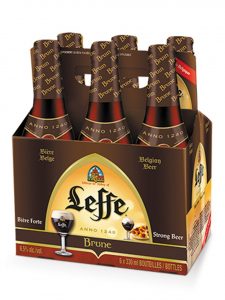
Intro
Dark, roasted, sweet, vanilla, cloves. These are some of the few words used to describe Leffe Beer. A brown ale whose history goes back to 1240 in a small abbey in Dinant, Belgium. Originally a traditional Trapist Beer its history is tied to the Abbey in which it was created.
Origins
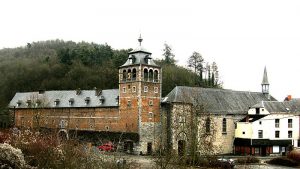
The Abbey of Notre-Dame de Leffe was founded in 1152 in Southern Belgium (Leffe, 2021). The Cannons where in many ways like Monks. They lived in a community, followed a code of rules, preached and prayed. However, unlike monks the Cannons were found to be very open and very welcoming of guests or “outsiders.” Many travelers who passed through the Abbey were met with welcoming and open arms. This earned the Abbey the reputation of being a good and safe place to rest for the night.
Another way the Cannons were similar to the Monks of the time period is that in 1240 they began to brew Beer at the Abbey (Leffe, 2021). During this time, various plagues were present and working their way through Europe. By many beers were considered to be a safer drinking option than water. This gained the Abbey notoriety both locally and beyond.
As the eighteenth century came and went so to did the French Revolution. During this time religion and religious life were at a standstill. The Abbey suffered as a result of the French Revolution and was destroyed several times. In 1794 the Abbey was abandoned and its Brewery destroyed. In 1902 the cannons were able to once again return to the abbey. (Wikipedia, 2021)
As time went on the Cannons slowly rebuilt and reestablished in the abbey. In 1952 (Leffe, 2021) Father Abbot Nys and brewer Albert Lootvoet, along with his brewery (Lootvoet brewery), entered a partnership and revived the old brewing traditions of the abbey (Leffe, 2021). Since then, Leffe is no longer considered a Trappist Beer.
Key Milestones
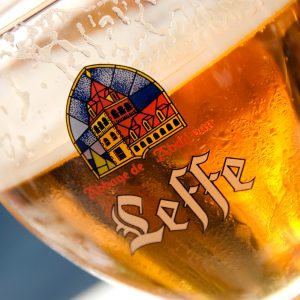
With such a long and rich history there are many milestones that have helped to make Leffe Beer what it is today. Some of these milestones include;
- 1152- The establishment of abbey Notre-Dame de Leffe in Dinant Belgium by the Cannons. (Leffe, 2021)
- 1240- As plague and sickness tore its way through Europe it was held a general belief that water was not safe to drink and that beer was safer. This led to the Cannons of the abbey making Leffe beer. (Leffe, 2021)
- 1794- the Abbey is destroyed and abandoned by the Cannons as a result of the French Revolution (Wikipedia, 2021).
- 1952- Brewing traditions are revised by Father Abbot Nys and a partnership entered with Lootvoet brewery (Leffe 2021). It is this very partnership that makes it so that Leffe Beer can no longer be considered a Trappist beer.
- 2017- Leffe Blond was awarded a gold medal at the World Beer Awards for the category of “World’s Best Belgian Style Blonde” (thebelgianbeercompany.com. 2021)
The Industrial Revolution
The arrival of the industrial revolution brought with it a vast and rich landscape of new technologies. These technologies would be used to help improve upon many aspects of life. One such aspect that would be impacted greatly, all over the world, was beer. This included and caused a large “beer revolution” across Europe (Belgian Shop, 2022.)
This included one of the large and early shifts was Beer manufacturing was moving from the farm fields and Abbeys across Europe and moving operations into lager cities and bigger breweries. On one hand we have beer production booming in the rural areas and on the other it’s moving further away from the rural areas. With the industrial revolution also came the invention and widespread use of the steam engine. This would be the early stages of Europe’s world-renowned rail system. With this came the ability to transport beers from town to town, city to city, and county to country. England was tasting Lagers from Germany. Germany was tasting Trappist Ales from Belgium. Beer ceased to be so “regional” and different countries were brewing and putting their on spin on beers from all over Europe (beer and brewing, 2022.)
Unfortunately for Leffe the Abbey was inoperable during this time period. As stated earlier in the chapter, Leffe was abandoned during the time period of the French Revolution. It was reclaimed in 1902 but a series of problems (fire, rebuilding, changing of ownership, etc.) Leffe would not begin brewing again until 1952 (Leffe, 2022.)
Beer Style
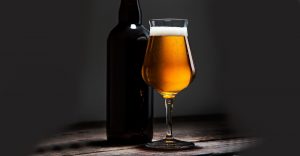
Leffe Blond is categorized as a “Belgian Pale Ale” (Leffe, 2022.) Although it is hard to pin point exactly when the first Belgian Pale Ale was produced. It is believed to have been in the mid – 1700’s (Kegerator.com, 2022.)
A specific guide line is set and this will dictate what makes a Belgian Pale Ale. This guide line is set in place by the Beer Judge Certification Program (BJCP) Style Committee (kegerator.com, 2022.) Things such as
Appearance:
Belgian Pale Ales are lighter in colour but sometimes lean towards an amber colour. When poured it is crowned with a large, pillowy, head. The head coats the glass and “falls faster than other Belgian Ales” (the Beer Judge Certification Program (BJCP) Style Committee, 2022.)
Aroma:
A malty aroma often referred to as being “pastry / biscuit like” (the Beer Judge Certification Program (BJCP) Style Committee.) A softer note of fruit, most noticeably, pear and orange. The hop profile is very soft but sometimes can lean into a mid-range.
Leffe, however, states their beer leans more into the malty, biscuit, aromoa. Highlighting strong notes of vanilla and clove (Leffe, 2022.)
Taste:
A lot of the tasting notes are similar to the aroma notes. Malty, bread, biscuit. With subtle hints of fruit and a low hop profile (the Beer Judge Certification Program (BJCP) Style Committee.)
Similarly, Leffe highlights a strong malt flavour, with soft hints of vanilla and clove and a sweet bitterness (Leffe, 2022.)
Pairings:
Leffe is best paired with foods it will enhance the flavours of. Strong Cheese, Crème Brule and Scallops are said to be best paired with Leffe (Leffe, 2022.)
Glassware:
For Belgian Pale ales the recommended glass is a Tulip Glass (A.K.A. Belgian Glass.) This glass has a bulb like body that is best for capturing aromas and head of Belgian pale ales (Kegworks.com, 2022.)
World War 1

In 1914 Belgium was invaded by Germany. Cities, towns, farms, abbeys, were all but destroyed and Germany held a strong occupation of Belgium. Of course, as a consequence the entire brewing industry of Belgium was severely affected. The raw materials needed to brew beer were scarce and rationed. This made a once guaranteed, easily accessible crop, not guaranteed and harder to get. On top of this the CNSA (National Relief and Food Committee) did not consider production of beer important, and thought sending the materials needed by breweries to not be of significant importance (Alcohol and the great war in Belgium, .rtbf.be, 2022.)
1915 saw a change in this opinion and the CNSA began to import and make available ingredients to brew masters in Belgium. Beer began to slowly and on a much smaller scale be once again brewed. However, in November of 1917 an order was put through by the British Government and the CNSA who were helping to provide Belgium with the materials to make beer. It stated that it required “all brewers wishing to participate in the distribution of barley or malts to provide a written commitment to comply with the conditions imposed by the government of His Britannic Majesty, failing which any brewer infringing them will be deprived of merchandise; meaning: A) that they will not share the delivered raw materials with anyone, B) that they will not sell beer to any German or to anyone acting on behalf of a German, C) that they will only supply establishments that have obtained the necessary licenses and that only sell beer for on-site consumption” (Alcohol and the great war in Belgium, .rtbf.be, 2022.) This would last until the war ended and as Belgium rebuilt so did its rich beer brewing industry.
World War 2
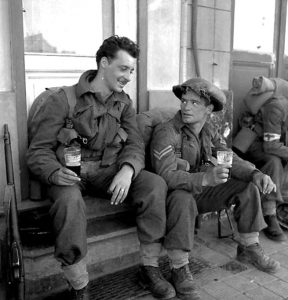
On May 10th 1940, Belgium was once again invaded by Germany. This would force Belgium into the second world war and it would prove to be a much longer, worse, and more catastrophic occupation than they saw in World War 1. The advancement in weaponry, military tactics, and the fact that Belgium was a “neutral / pacifist” country (Wikipedia, 2022) made the devastation far greater than they had seen in World War 1. Germany’s occupation saw massive destruction of most areas of Belgium and therefore the beer industry and production in Belgium was mostly halted as they were unable to brew safely. This would last until February of 1945. When Canadian, British, and American Soldiers helped to liberate Belgium. It wasn’t until after the war that Belgium would begin brewing in the numbers that they had seen before the war.
In the instance of both World War 1 and 2 Leffe was still inoperable and not brewing beer and wouldn’t begin until 1952 (Leffe, 2022.)
Consolidation
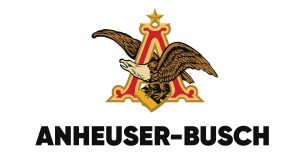
As World War 2 came to an end much of Europe was left in rubble and the country was tasked with rebuilding. In Europe at this time there was a boom in Brewing. Beer was now, more than ever, able to be shipped world wide and with all the foreign troops returning to their native countries there was a demand for the European Beers they came to love during World War 2. The demand for this brought in big corporations and corporate breweries to start buying and distributing a lot of the smaller and forgotten about beers of Europe. One such beer was Leffe. In 1952, seven years after the end of World War 2, Brewing traditions are revised by Father Abbot Nys (Leffe, 2022.) At the same time Father Abbot Nys enters in a partnership with Albert Lootvoet and Lootvoet Brewing (Leffe, 2022.) Since then, Lootvoet Brewing was bought by Interbrew which years later became Anheuser-Busch (Wikipedia, 2022.) It is said at the time to be the first deal of its kind. Although no longer considered a traditional Trappist beer, royalties are still paid to Abbaye Notre-Dame de Leffe to this very day (Wikipedia, 2022.)
Marketing and Branding

The Marketing and Branding of Leffe has overall been the same since 1952. Marketed as a Trappist Beer that had been perfected by monks (Leffe Lawsuit, Reuters.com, 2016.) Earthy colours of yellows, browns, orange and black. Coupled with old fashioned European style fonts and images of the Abbaye Notre-Dame de Leffe make you feel like you are drinking a small batch beer made in the abbey itself. Leffe’s marketing hinges so much on this that is 2016 an American sued Anheuser-Busch (Reuters.com, 2022.) The basis of the Lawsuit was that the rules of a Traditional Trappist Beer were not met and their claims of monks brewing a small batch beer was misleading. Another claim was that because of Leffe’s marketing it could be conceived that it was a craft beer (Reuters, 2022.) Since then, the marketing has slightly shifted. It is clearly stated that it is brewed by Anheuser-Busch and states on their website that it originated as a Trappist Beer (Leffe, 2022.)
Modern Era
As of today, Leffe is sold in every large market where beer and alcohol can be bought. As the beer industry is constantly changing and reinventing the wheel in an attempt to keep up with modern trends. Leffe has remained fairly consistent. It’s Blond and Brun Belgian Pale Ales have remained the same in flavour profile and in alcohol content. Still marketed as a small Trappist / Craft Beer feel but with a large audience and brewing standard behind it. As of 2022, Leffe continues this and maintains that drinking Leffe will evoke feelings of being in Belgium at the now infamous to Abbaye Notre-Dame de Leffe.

